Electromagnetic flowmeters, commonly used for measuring the flow rate of conductive liquids, operate on the principles of electromagnetic induction, as defined by Faraday’s Law of Electromagnetic Induction. They are widely used in various industries such as water treatment, chemical processing, and food and beverage production due to their high accuracy and lack of moving parts. Below, we explore the main components of an electromagnetic flowmeter and the role each plays in the overall function of the device.
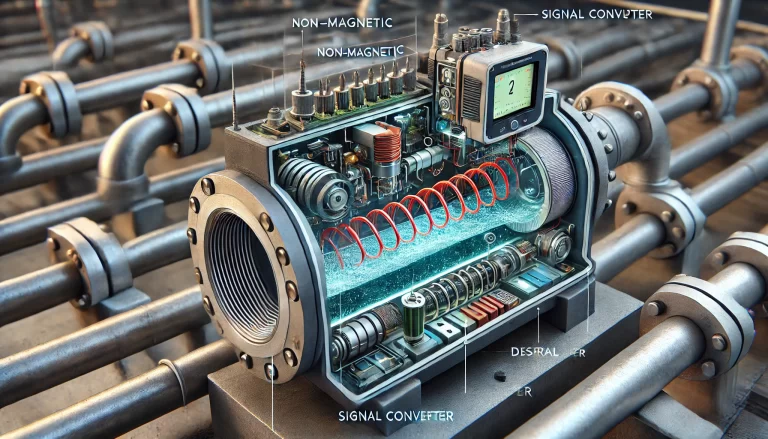
1. Sensor
The sensor is the core of the electromagnetic flowmeter. It typically consists of a non-magnetic measuring tube, electrodes, and coils. The purpose of the sensor is to measure the velocity of the liquid flowing through it. The measuring tube, often made from materials such as stainless steel or ceramic, provides a path for the conductive liquid. The tube must be non-magnetic to ensure that the magnetic field generated inside it remains unaffected by the surrounding material.
The principle of measurement is based on the fact that when a conductive liquid flows through a magnetic field, it induces a voltage proportional to the flow velocity. The sensor detects this voltage, which is directly related to the flow rate. The accuracy and design of the sensor are critical, as they directly affect the precision of the flowmeter.
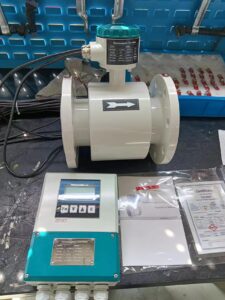
2. Magnetic Field (Excitation System)
The excitation system generates a magnetic field inside the flowmeter’s measuring tube. This system typically consists of a pair of coils positioned around the measuring tube. When an electric current is passed through these coils, a magnetic field is created perpendicular to the flow direction of the liquid.
Faraday’s Law states that when a conductor (in this case, the conductive liquid) moves through a magnetic field, a voltage is induced. This voltage is proportional to both the velocity of the liquid and the strength of the magnetic field. Therefore, the excitation system’s role is to maintain a stable and uniform magnetic field for accurate measurement. In modern electromagnetic flowmeters, pulse DC excitation is commonly used, which helps to enhance signal stability and reduce noise.
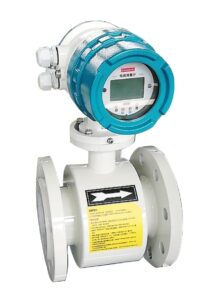
3. Electrodes
Electrodes are installed inside the measuring tube at specific positions (usually diametrically opposite each other) where they come into contact with the conductive liquid. Their function is to detect the small voltage that is induced when the liquid flows through the magnetic field. This voltage, which is proportional to the flow rate of the liquid, is transmitted to the signal processing system for further analysis.
The material of the electrodes must be carefully selected to ensure durability and to prevent corrosion, especially when measuring aggressive or corrosive fluids. Common materials for electrodes include stainless steel, platinum, or tantalum, depending on the nature of the liquid being measured.
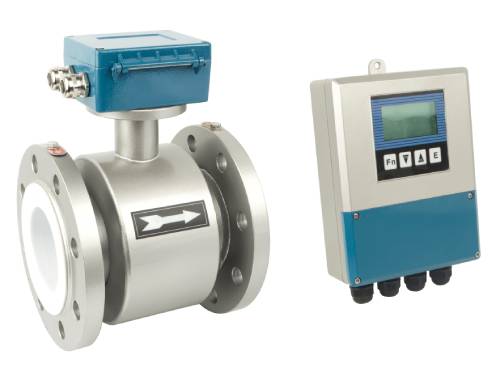
4. Signal Converter (Transmitter)
The signal converter is responsible for processing the voltage signal detected by the electrodes. Since the voltage generated is often very small (in the millivolt range), the converter amplifies the signal to a usable level. After amplification, the converter processes the signal and transforms it into a proportional output that reflects the flow rate of the liquid.
Modern converters can handle a wide range of functions. They are equipped with digital displays, allowing operators to view flow rate information directly. They also support various output formats, such as 4-20mA current signals, pulse outputs, or digital communication protocols like HART, PROFIBUS, or Modbus for integration into a larger process control system.
Some advanced converters include diagnostic features, allowing the flowmeter to monitor itself for any irregularities such as electrode fouling or changes in the magnetic field strength. This enhances the reliability and ease of maintenance of the flowmeter.
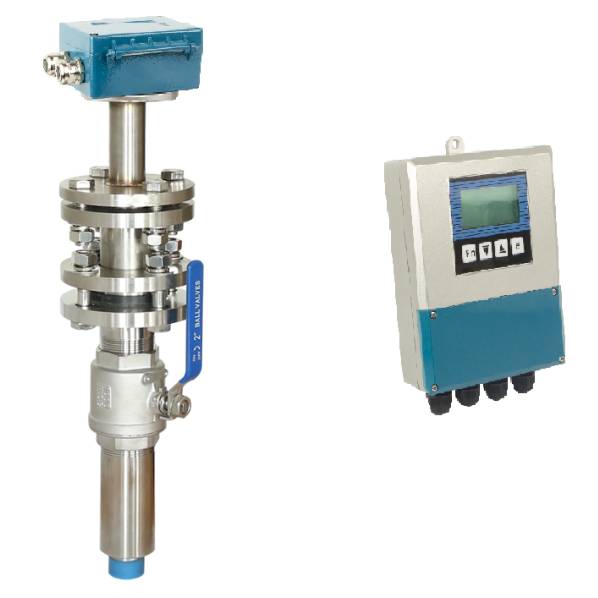
5. Display and Output System
The display and output system of an electromagnetic flowmeter provides the user with real-time flow rate information. In addition to showing the instantaneous flow rate, many flowmeters can display totalized flow, which is the cumulative volume of fluid that has passed through the meter over a certain period.
In addition to a local display, electromagnetic flowmeters are typically equipped with output interfaces that allow them to communicate with remote systems. Analog outputs (like 4-20mA signals) or digital communication protocols enable integration with centralized control systems (e.g., SCADA or DCS) for continuous monitoring and control of the process.
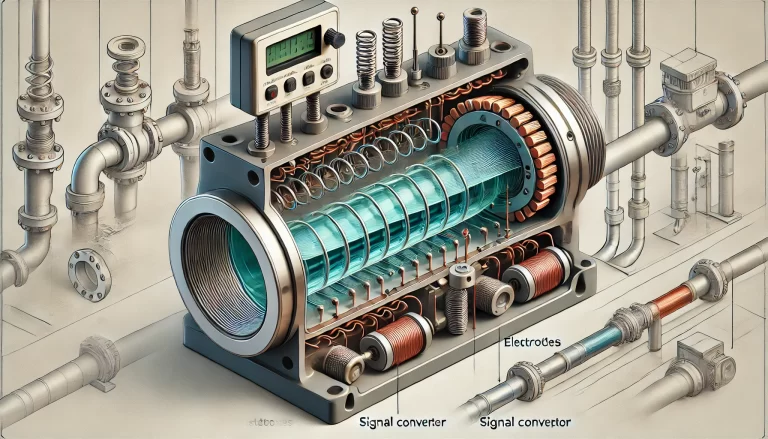
6. Housing
The housing or enclosure of the electromagnetic flowmeter is designed to protect the internal components from environmental factors such as dust, moisture, and corrosive gases. The housing is typically made from robust materials like stainless steel or aluminum, and it must meet certain industrial standards for durability, such as IP67 or IP68 for water and dust resistance.
In hazardous environments, flowmeter housings may also be explosion-proof, ensuring they can operate safely without posing risks of ignition. This is especially important in industries such as petrochemicals and mining.
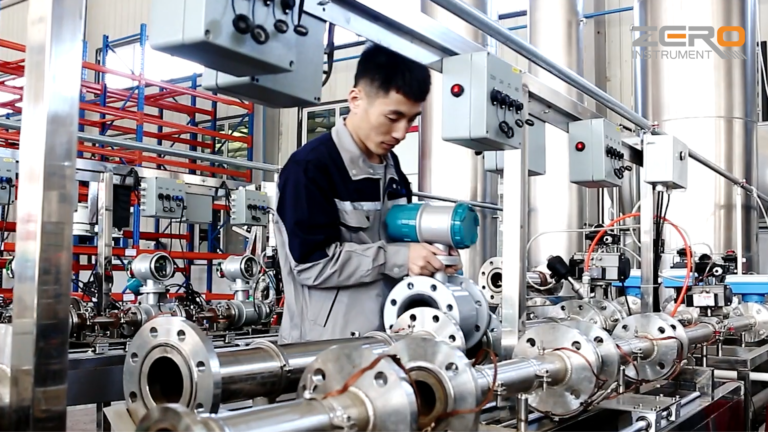
Working Principle
When a conductive liquid passes through the flowmeter’s magnetic field, a voltage is induced in the liquid. The electrodes detect this voltage, which is directly proportional to the flow rate. The signal is transmitted to the signal converter, which amplifies and processes it, turning it into a readable flow rate displayed on the screen or transmitted to a control system. The relationship between the induced voltage (E), the flow velocity (V), and the magnetic field (B) is described by the equation:
E=B×V×D
Where:
- E is the induced voltage,
- B is the magnetic field strength,
- V is the flow velocity,
- D is the diameter of the pipe.
Thus, by measuring the voltage, the flowmeter can calculate the velocity of the liquid and, consequently, the flow rate.

Applications
Electromagnetic flowmeters are ideal for measuring conductive liquids, including:
- Water and wastewater treatment,
- Chemical processing,
- Food and beverage industries,
- Pulp and paper industries.
They are especially useful in situations where high accuracy is required and where other types of flowmeters might be affected by factors such as contamination, pressure loss, or the presence of solid particles.

Conclusion
Electromagnetic flowmeters offer a reliable, accurate, and maintenance-free solution for flow measurement in a wide range of industries. Their robust design, lack of moving parts, and ability to handle a variety of fluids make them an essential tool for modern process control systems. The combination of sensor technology, precise magnetic field control, and advanced signal processing ensures that these devices can operate efficiently in even the harshest environments.
